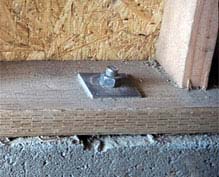by John Eberhard
 From my perspective as a former full time musician I used to be oriented to music by the name of the decade it came from; the 50s, the 60s, the 70s, the 80s, the 90s, and so on. Here we are coming to a close of the first decade of the new millennium and there has not even been a widely accepted name for it yet. I heard a reference to the decade recently as the “oughts.” We’ll see if that one sticks.
From my perspective as a former full time musician I used to be oriented to music by the name of the decade it came from; the 50s, the 60s, the 70s, the 80s, the 90s, and so on. Here we are coming to a close of the first decade of the new millennium and there has not even been a widely accepted name for it yet. I heard a reference to the decade recently as the “oughts.” We’ll see if that one sticks.
Timothy Noah, on Slate.com, stated at the end of 2004: “The most logical candidate is a term often used to describe the first decade of the 20th century: the "aughts." But despite heavy promotion from journalists and others, it's never caught on.”
Five years on, and still no name for the decade. Oh well.
I’ve made it a habit over the last few years to name what I thought would be the most important Internet marketing strategies for the coming year.
Here’s what I said for the most important strategies for the beginning of 2008:
a. Pay-Per-Click Search Engine Advertising
b. Article Directories / Content Hubs
c. Optimized Press Releases
d. SEO (Search Engine Optimization) Actions Done to a Web Site
e. Email Marketing
f. Banner Ads
g. Web 2.0
Here’s what I said for the most important strategies for the beginning of 2009:
a. Pay-Per-Click Search Engine Advertising
b. Blogs
c. Online PR
d. Social Media
e. Video and Audio on Sites and Blogs
f. Article Directories / Content Hubs
Interestingly, in an industry that thrives on change, there was not a lot of change from 08 to 09. Certainly banner ads are not a major force anymore. Article directories are less of a force than they were a couple years ago but are still very effective. Blogs and online PR are still very effective. Social media has become a more dominant force in online marketing in 2009.
My Website Marketing Picks for 2010
As we prepare to enter the new decade (which we assume will be called the “Teens”) here is my prediction for the best website marketing strategies for the next year.
a. Pay Per Click Advertising: PPC is still a very dominant force and very effective, though its use is pretty much limited to high ticket items because of its cost. I was concerned a couple of years ago because of the multitude of companies that had begun using PPC and the resultant rise in bids and higher cost per click. I suspected that either the competition would have a self-normalling effect, driving some players out of the market and cost per click prices would fall somewhat, or the high costs would make the medium irrelevant eventually. Happily the former has occurred. PPC is an excellent way to drive traffic to your site on an immediate basis, and due to the excellent statistical and monitoring tools, in skilled hands it can be very effective. It’s just not viable for selling books and CDs.
b. Social Media: I have a friend who was bugging me to get into social media a couple years ago when I was reluctant, and he loses no opportunity to remind me of it when the topic comes up. Facebook is the #3 site in November according to Compete.com with 128 million unique visitors. YouTube is #4 with 85 million visitors. Twitter is #43 with 22 million visitors. True enough, social media has become a dominant force in website marketing, as long as you know how to use it. This means developing lots of friends/followers/connections, then sprinkling your marketing message into the conversation in a tasteful, non-offensive way. Shouts of “buy my stuff,” “buy my stuff,” “buy my stuff” at every opportunity will not work, because people can easily sever their connection to you and will. For my business I find it works to post several things a day saying what I am doing, such as “I am working on designing a new web site for a veterinarian,” or “I am ghost writing an article for a client.” It’s not obnoxious (at least I hope not) and it regularly reminds people of who I am and what I do. And I get business from Facebook and Twitter.
c. Single Dissemination Points Out to Multiple Sites: I believe that one of the primary essences of marketing is to have one message and to send it out as broadly as possible, without having to initiate the communication over and over again yourself. For this reason I really like sites that allow you to put out one communication one time, and have it go out to multiple places. I use Ping.fm to type in short communications (140 characters which is the Twitter limit) and I have it configured to post the message to Facebook, Twitter, LinkedIn, MySpace, Plaxo, and several other sites. So every time I post an update it goes out to 11 sites and to all my friends on those sites. I use Posterous.com for posting longer communications to my blogs, and I have it configured so it goes out to my blogs on Typepad, Wordpress.com, Blogger.com and several other blog sites.
d. Keyword Research: I think keyword research is vital to do at the beginning of your website marketing efforts. The reason is because search engines base all their ranking on keywords. You do not just rank well or poorly on a search engine. You rank well or poorly for specific keywords. And it does practically no good to rank well for a keyword that no one searches for. But at the same time, if you think you are going to be able to rank well for general, single word, category keywords like “golf,” “computers,” “furniture,” or “mp3,” I’m afraid that just isn’t going to happen. There is way too much competition for those keywords. So the key is to find keywords that have decent traffic but not a jillion sites competing for them. Then work those golden nugget keywords into your strategy for blogs, online PR, social media, article marketing and so on.
e. Email Marketing: I first got into email marketing when it was a newfangled thing back in 1998-99, and made millions with it for the company I was working for at the time. Unfortunately a few years after that saw “the deluge.” By that I mean the flood of mostly small businesses flooding cyberspace with their sales emails promoting stock picks, male enhancement products, printer toner cartridges, and a host of other products. And most engaged in tactics that were considered unethical then and are against the law now, such as not removing you if you asked, using deceptive subject lines and so on. My observation is this killed the market for rented email lists. But what does still work today and work well, is developing an in-house email list of customers and prospects who inquire about your products and services, and emailing to them regularly. It works great for selling your products. Just comply with the CAN-SPAM Act.
f. Blogs: I have written extensively about the effectiveness of blogs (some have kidded me about how much). I still believe that they are one of the best things you can do. Blog on Macduff.
g. Online PR: Optimized press releases, containing your target keywords that you found when you did keyword research and submitted to online PR sites, are very effective in building quality links to your website. These links also rank very well in the search engines.
h. Article Directories: I think article directories have become the ugly stepchild of Internet marketing in the last year, because no one in the SEO community talks about them (they rarely ever did for reasons unknown) and the number of directories have dropped off. But I do this for my own sites and for several clients and it still works like gangbusters in developing quantity links.
That’s it. Best wishes for 2010 and may you have the most prosperous year yet. Remember, if you market yourself properly, you can overcome all this “economic uncertainty” and together we will.

 Keywords are an important subject when doing just about any marketing on the Internet. These are words or phrases that people are going to be typing into the various search engines.
Keywords are an important subject when doing just about any marketing on the Internet. These are words or phrases that people are going to be typing into the various search engines. Someone called me up recently saying that someone had walked into their office and said he could guarantee them the #1 position on Google for two specific keywords related to his business. My contact wanted to know what I thought of this?
Someone called me up recently saying that someone had walked into their office and said he could guarantee them the #1 position on Google for two specific keywords related to his business. My contact wanted to know what I thought of this?



 Facebook and Twitter are the biggest social media sites right now. Both can be used effectively for marketing purposes, but you have to know how.
Facebook and Twitter are the biggest social media sites right now. Both can be used effectively for marketing purposes, but you have to know how.
 Google has stated that its main criteria for how high your site will rank in their search engine, is the number of links to your site from other websites. So that means one important activity for any website owner is
Google has stated that its main criteria for how high your site will rank in their search engine, is the number of links to your site from other websites. So that means one important activity for any website owner is 
 Campaign to Include Pay Per Click, Blogs, Article Directories, Optimized Press Releases & Social Media
Campaign to Include Pay Per Click, Blogs, Article Directories, Optimized Press Releases & Social Media Every web site owner would like to increase the amount of traffic to his or her site. I have been pushing the idea for a year or so that creating a blog, and then posting content to it on a regular basis, drives traffic to your web site. But I find that even people for whom I have created and set up blogs don’t get how or why this happens. So I am devoting this entire article to explaining how this works.
Every web site owner would like to increase the amount of traffic to his or her site. I have been pushing the idea for a year or so that creating a blog, and then posting content to it on a regular basis, drives traffic to your web site. But I find that even people for whom I have created and set up blogs don’t get how or why this happens. So I am devoting this entire article to explaining how this works. Link building
Link building Link building
Link building Julian Construction (
Julian Construction ( MEDFORD, OR: Aero & Marine Tax Professionals, (
MEDFORD, OR: Aero & Marine Tax Professionals, ( One of the most important aspects of managing a web site is finding out and then monitoring regularly, how much traffic is coming to the site.
One of the most important aspects of managing a web site is finding out and then monitoring regularly, how much traffic is coming to the site.
